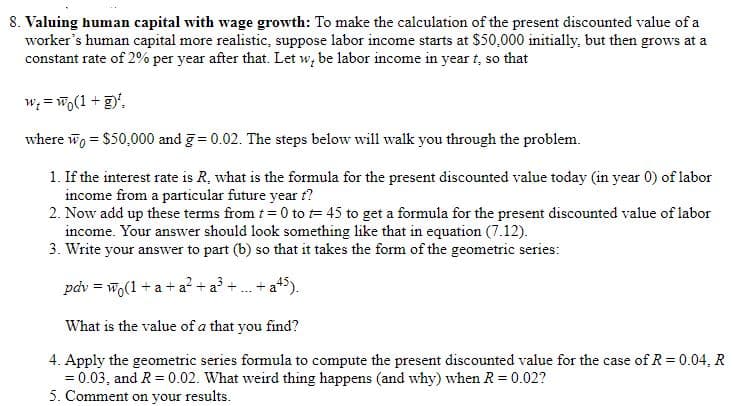3. Write your answer to part (b) so that it takes the form of the geometric series: pdv = w,(1+ a + a? +a? +. + a5). ... What is the value of a that you find? 4. Apply the geometric series formula to compute the present discounted value for the case of R = 0.04, R = 0.03, and R= 0.02. What weird thing happens (and why) when R= 0.02? 5. Comment on your results.
3. Write your answer to part (b) so that it takes the form of the geometric series: pdv = w,(1+ a + a? +a? +. + a5). ... What is the value of a that you find? 4. Apply the geometric series formula to compute the present discounted value for the case of R = 0.04, R = 0.03, and R= 0.02. What weird thing happens (and why) when R= 0.02? 5. Comment on your results.
Chapter14: Capital Structure Management In Practice
Section: Chapter Questions
Problem 28P
Related questions
Question
part 3 4 5

Transcribed Image Text:8. Valuing human capital with wage growth: To make the calculation of the present discounted value of a
worker's human capital more realistic, suppose labor income starts at $50,000 initially, but then grows at a
constant rate of 2% per year after that. Let w, be labor income in year t, so that
w; = Wo(1 +',
where wo = $50,000 and g= 0.02. The steps below will walk you through the problem.
1. If the interest rate is R, what is the formula for the present discounted value today (in year 0) of labor
income from a particular future year t?
2. Now add up these terms from t = 0 to = 45 to get a formula for the present discounted value of labor
income. Your answer should look something like that in equation (7.12).
3. Write your answer to part (b) so that it takes the form of the geometric series:
pdv = w.(1 + a + a? + a³ + .
+ at5).
What is the value of a that you find?
4. Apply the geometric series formula to compute the present discounted value for the case of R= 0.04, R
= 0.03, and R = 0.02. What weird thing happens (and why) when R = 0.02?
5. Comment on your results.
Expert Solution
This question has been solved!
Explore an expertly crafted, step-by-step solution for a thorough understanding of key concepts.
This is a popular solution!
Trending now
This is a popular solution!
Step by step
Solved in 2 steps with 2 images

Knowledge Booster
Learn more about
Need a deep-dive on the concept behind this application? Look no further. Learn more about this topic, finance and related others by exploring similar questions and additional content below.Recommended textbooks for you

EBK CONTEMPORARY FINANCIAL MANAGEMENT
Finance
ISBN:
9781337514835
Author:
MOYER
Publisher:
CENGAGE LEARNING - CONSIGNMENT



EBK CONTEMPORARY FINANCIAL MANAGEMENT
Finance
ISBN:
9781337514835
Author:
MOYER
Publisher:
CENGAGE LEARNING - CONSIGNMENT

